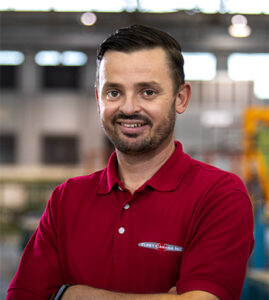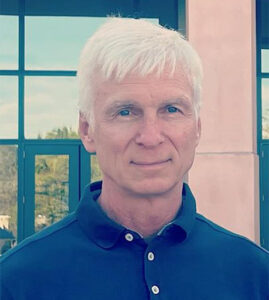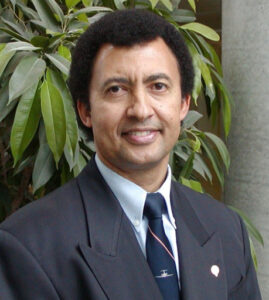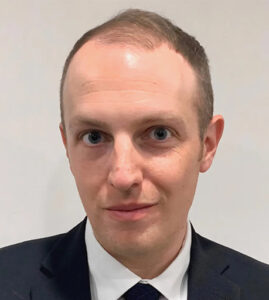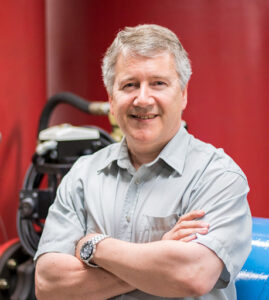
WESCAM MX™-15D, Airborne Targeting and Designating
Image Credit: L3Harris
In 1957, Westinghouse Canada in Hamilton won a contract from the Canadian Armament Research and Development Establishment (CARDE) in Valcartier, Quebec to develop a close-circuit TV camera system that an armoured car crew could use to identify a tank-size object five kilometres away using a long lens. In 1960, the Westinghouse engineering team came up with the idea of a gyro-stabilized camera mount and that led to a new program to fly the TV camera beneath a small unmanned 50 pound electric-powered helicopter with a 4 ½ diameter coaxial rotor system called the Servotech Periscopter, which was tethered to the ground by a cable that could transmit TV images.
When the Canadian military cancelled funding in 1967, new commercial customers had to be found for a new system called the WESSCAM (Westinghouse Stabilised and Steered Camera Mount), which was a steerable gyrostabilized camera mount housed in a large fiberglass dome. In April 1969, photos of the remote control, vibration-isolated, gyro-stabilized WESSCAM camera platform mounted to the underside of a Bell 206A JetRanger helicopter flying over Toronto were published in Flight International magazine. It allowed exceptionally long lenses to be used for film, TV and surveillance work while still giving a jitter-free image. Westinghouse built 20 units for military and commercial use.
In 1974, Westinghouse engineer John Noxon “Nox” Leavitt bought the patents for the camera mount system from Westinghouse Canada and founded Istec Ltd. to further develop the renamed Wescam Camera System.
By 1984, the 16-employee company had sold more than 50 of the $150,000 Westcam mounts (without a camera) and Istec mounts were in use in the USSR, Japan, the Middle East, Europe, the US and Canada. The camera mount can pan through 360 degrees and tilt up 30 degrees or down 90 degrees.
In the mid-1980s, Istec was developing a 70 mm stereo camera system to be used by the National Film Board to produce a film for the EXPO’86 World Exposition in Vancouver.
Early TV credits included 98 percent of the aerial views of the 1984 Olympics, the Pope’s visit to Canada in 1993, regular aerial views of the launch of the NASA Space Shuttle, and the 1993 slow speed police case of O.J. Simpson through Los Angeles in 1993. Early movie credits included Star Wars and Superman I, II and III before the list exploded to hundreds of move credits.
In 1987, a management buyout launched a new era in Wescam innovation. By 1993, Istec Inc. had 100 employees, revenues of $11 million, up from $1 million in 1987, with Wescam units with cameras installed selling for between $250,000 and $500,000 each. That year the company made 384 rentals in the sports and entertainment industry, including 100 commercials, 32 feature films and 252 live video productions.
In 1995, the Istec changed its name to Wescam Inc., and went public on the Toronto stock Exchange raising about $40 million in fresh investment to boost “gimbal ball” production at a new building in a Hamilton industrial park.
The company experienced 30 to 50 percent annual growth rates between 1997 and 2001 and employment grew to 550 as new gymbal systems were developed.
After 9/11, FAA airspace restrictions over major sporting events hit an important part of Wescam’s business and the industry went through a period of consolidation.
U.S. defence contractor L-3 Communications bought Wescam in 2002, it was mostly interested in the military and security business, so its motion picture and broadcasting business was spun off to Pictorvision which was founded by former employees.
The company’s airborne product line became the MX Series, a family of turrets from 10 to 25 inches in diameter, the smallest of which weighs just 37 pounds (168 kg) which can contain both imaging and laser systems. By 2014, more than 2500 of the MX series turrets are in use in 65 countries, and on more than 120 different airborne platforms. And the system was also adapted for use on military vehicles and warships. In June 2020, L3 Wescam, announced plans for a 330,000-square-foot head office in the nearby community of Waterdown. More than 1,000 employees working at company facilities in Burlington moved to the new Waterdown building with an estimated 200 new hires.
– Kenneth Swartz
Today, students from Centennial College, Toronto Metropolitan University, Queens University, McMaster University, York University and the University of Toronto are working together on collaborative DAIR projects, developing skills and helping to build an even stronger aerospace industry for Ontario and Canada.
